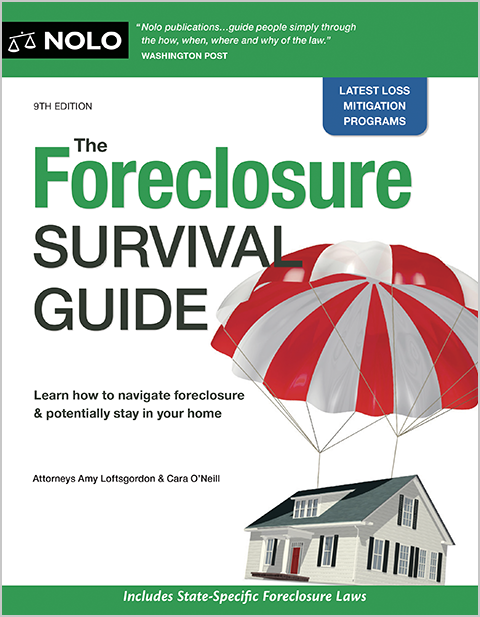Here are some ways to avoid foreclosure.
If you're worried about missing mortgage payments and facing foreclosure, you're not alone. Thousands of homeowners are looking for effective mortgage relief and foreclosure avoidance options. If you're experiencing a financial hardship due to job loss, unexpected expenses, or even a government shutdown, understanding your loss mitigation options can help you save your home (or find a way to give it up while going through as little stress as possible).
This article explains options, including repayment plans, loan modifications, forbearances, short sales, and deeds in lieu of foreclosure, as well as special options if you have an FHA, a VA, or a Fannie Mae or Freddie Mac loan.
- What Should I Do If I Can't Make My Mortgage Payments?
- What Is a Mortgage Repayment Plan and How Does It Work?
- How Do I Reinstate My Mortgage to Stop Foreclosure?
- Understanding Redemption: Can I Pay Off My Mortgage and Keep My Home?
- Can I Stop Foreclosure With a Forbearance? Mortgage Payment Pause Explained
- What Is a Loan Modification and Can It Lower My Mortgage Payments?
- Should I Refinance My Mortgage to Avoid Foreclosure
- Short Sale vs. Deed in Lieu of Foreclosure: Ways to Give Up Your Home
- How Do FHA, VA, USDA, Fannie Mae, and Freddie Mac Loans Affect Foreclosure Options?
- Where to Get Help Avoiding Foreclosure: HUD Housing Counselors and Legal Advice
What Should I Do If I Can't Make My Mortgage Payments?
If you're struggling to make your mortgage payments and facing a possible foreclosure, you might be able to work something out with your loan servicer.
For instance, you might be able to arrange a:
- repayment plan, negotiated after you've fallen behind in payments
- reinstatement, in which you bring the loan current
- redemption, where you pay off the total loan amount
- forbearance, usually prearranged before you fall behind (but not always)
- loan modification, negotiated either before you fall behind or after you're already delinquent on the loan
- refinance, typically arranged before you're behind in payments and if you have equity in the home
- short sale, where you sell the property before the foreclosure ends, or
- deed in lieu of foreclosure, in which you give the home to the lender.
What Is a Mortgage Repayment Plan and How Does It Work?
With a repayment plan, you arrange to make up your missed payments over time and stay current on your ongoing payments. This approach is usually the most feasible and easiest to work out with your servicer.
For a repayment plan to work, your income will have to be able to cover both current and makeup payments. Repayment plans typically last three, six, or nine months. Servicers usually don't offer longer plans because most borrowers find it difficult to make larger-than-normal payments for an extended amount of time. For example, say you're four months behind on your payments of $1,500 a month, for a total of $6,000. Paying $2,500 each month (an extra $1,000 per month) over the next six months would bring you current.
Sometimes, the servicer can approve a repayment plan immediately without asking the lender for approval. The longer it will take you to catch up, the likelier your servicer will have to get permission from the lender.
How Do I Reinstate My Mortgage to Stop Foreclosure?
Many states give you, by law, the right to reinstate your loan by paying the overdue amounts in a lump sum. Or your mortgage contract might give you a set amount of time to reinstate and stop a foreclosure. Also, the lender might agree to allow a reinstatement.
Understanding Redemption: Can I Pay Off My Mortgage and Keep My Home?
In all states, you can redeem the home (pay off the entire loan) before a foreclosure sale. Redeeming will prevent the sale from happening.
Some states also give the borrower some time after the sale to redeem the property by paying the mortgage loan off in full, plus interest and costs, or reimbursing whoever bought the home at the foreclosure sale.
Can I Stop Foreclosure With a Forbearance? Mortgage Payment Pause Explained
Under a forbearance agreement, the servicer or lender agrees to reduce or suspend your mortgage payments for a specific amount of time. In exchange, you promise to start making your full payment at the end of the forbearance period and repay the skipped amounts in a lump sum, in a repayment plan, or by completing a modification in which the lender adds the overdue amounts to the loan balance. Or you might be able to arrange payment deferral, where you pay the skipped amounts at the end of the loan.
Forbearance for three to six months is typical, though a longer period might be possible, depending on the lender's guidelines and your situation.
With a forbearance, the lender sometimes agrees in advance for you to miss or make reduced payments. However, with some kinds of forbearances, you don't have to be current on the loan when you get the forbearance.
What Is a Loan Modification and Can It Lower My Mortgage Payments?
Unlike repayment plans and forbearances, mortgage modifications are designed to lower your monthly payments over the long term and, often, bring you current on the loan. If you can't afford your monthly payment now or won't be able to soon, a loan modification is most likely the best approach to remaining in your house.
Some reasons why you might need a modification include:
- A layoff or injury disrupted your income stream, and a new job at the same pay isn't available.
- The interest rate reset higher.
- Something happened that required you to reprioritize your budget—for instance, a medical emergency or a child in trouble.
How Loan Modifications Work
Here's how your servicer might modify your mortgage to reduce the monthly payments.
- Reduce your loan's interest rate to the current market rate if it's lower than what you should be paying now.
- Convert a variable rate to a fixed rate, which could decrease the payment.
- Extend the loan's repayment period, for instance, from 30 years to 40, which will lower the monthly payment but delay when you can begin building equity.
- Forbear some of the principal balance. ("Forbearing" the principal means setting aside a portion of the total debt before calculating the borrower's monthly payment. The borrower typically has to pay the set-aside amount in a balloon payment when refinancing or selling the home or when the loan matures.)
- Reamortize the loan, which involves adding the amount of the missed payments to the principal balance and usually issuing a new interest rate for a new period of time. Reamortization can result in an increased payment (for example, if the interest rate stays the same or increases) or a reduced one (for example, if the interest rate is reduced and the loan period is increased).
Should I Refinance My Mortgage to Avoid Foreclosure
In most cases, refinancing is available only if you have equity in your home and you have acceptable credit scores, which means you can't be delinquent on the loan.
You might be able to refinance your loan even if your mortgage is delinquent, but the odds aren't good. Contact your current lender to find out if they have any available programs. Your current lender might be more willing to refinance a delinquent mortgage than other lenders.
Short Sale vs. Deed in Lieu of Foreclosure: Ways to Give Up Your Home
In a short sale, the lender agrees to let the homeowner sell the home to a new owner for less than is owed on the mortgage loan. In a deed in lieu of foreclosure transaction, a homeowner voluntarily hands over the home's title to the bank to satisfy the mortgage loan.
How Do FHA, VA, USDA, Fannie Mae, and Freddie Mac Loans Affect Foreclosure Options?
Special loss mitigation options (for both keeping or giving up your home) are available to you if your mortgage is FHA-insured, VA-guaranteed, or Fannie Mae or Freddie Mac owned or guaranteed. Your mortgage servicer can give you more information about the special options available for your particular type of mortgage, including those discussed below.
Fannie Mae and Freddie Mac Loans
Fannie Mae and Freddie Mac offer various foreclosure alternatives, including the Flex Modification program, among other types of options, to borrowers having trouble making their mortgage payments. Eligible borrowers can expect to receive a 20% payment reduction through a Flex Mortgage Modification.
To be eligible for a Flex Modification or other foreclosure alternatives offered through these entities, Fannie Mae or Freddie Mac must own your loan. Check the Fannie Mae Loan Lookup Tool and Freddie Mac Loan Look-Up Tool to find out. Many loans are sold to these government-sponsored enterprises.
FHA-Insured Loans
If you have an FHA-insured loan and are behind in payments, or about to fall behind, your servicer will evaluate for loss mitigation alternatives using what's called a "waterfall" process. The servicer must evaluate the borrower for these loss mitigation alternatives in the following order:
- repayment plan
- forbearance
- standalone partial claim
- standalone loan modification
- loan modification plus partial claim
- payment supplement
- outside of the waterfall loan modification
- preforeclosure sale (short sale), or
- deed in lieu of foreclosure.
The evaluation stops when the borrower qualifies for one of these options.
VA-Guaranteed Loans
If you have a VA loan, you might qualify for a special loss mitigation option, such as a partial claim. Borrowers with VA-insured loans should contact their mortgage servicer to find out about options.
Where to Get Help Avoiding Foreclosure: HUD Housing Counselors and Legal Advice
Contact your servicer to find out if you're eligible for a loss mitigation option and how to apply. If you need more information about different ways to avoid foreclosure, help applying for a loss mitigation option, or want to learn how to fight a foreclosure, consider talking to a foreclosure attorney or a HUD-approved housing counselor.
- What Should I Do If I Can't Make My Mortgage Payments?
- What Is a Mortgage Repayment Plan and How Does It Work?
- How Do I Reinstate My Mortgage to Stop Foreclosure?
- Understanding Redemption: Can I Pay Off My Mortgage and Keep My Home?
- Can I Stop Foreclosure With a Forbearance? Mortgage Payment Pause Explained
- What Is a Loan Modification and Can It Lower My Mortgage Payments?
- Should I Refinance My Mortgage to Avoid Foreclosure
- Short Sale vs. Deed in Lieu of Foreclosure: Ways to Give Up Your Home
- How Do FHA, VA, USDA, Fannie Mae, and Freddie Mac Loans Affect Foreclosure Options?
- Where to Get Help Avoiding Foreclosure: HUD Housing Counselors and Legal Advice

